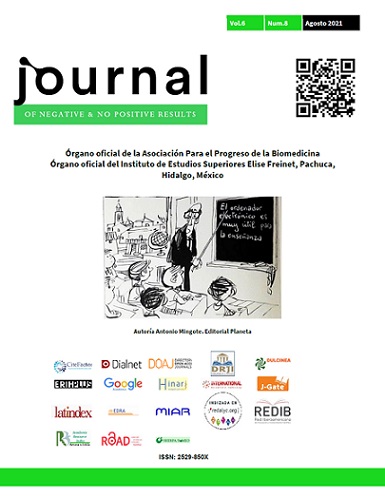Syndrome of cyber-phubbing “Its impact on interpersonal relationships and human health”
DOI:
https://doi.org/10.19230/jonnpr.4104Abstract
Nowadays technology has acquired a significant role in our lives; social networking, internet, video games and mobile devices became the primary communication and interaction. Even though this phenomenon may represent a “double edged sword” providing us of positive but also negative results, the internet addiction problem that occurs when people develop a dependence on internet connectivity, might even lead them to have symptoms of anxiety and violence reporting “abstinence periods” when they don´t have access to a network source and generate similar brain alterations that alcohol and drugs does [Phubbing].
Aim. To describe the impact that reflects the technology as a risk factor on interpersonal relations in our environment, as well as locate the possible physiological consequences that these can cause.
Method. Sectional survey applied on two groups of 50 students, between 2014-2106.
Results. Results throw us that the impact of social media addiction, internet and cell phone´s usefulness represents therefore a significant risk for their health, to hinder emotional relationships within their family and personal impact on cognitive and emotional health. The negative impact is personal and collective, enphasizing the cell phone use while driving a vehicle and its addiction (Phubbing) causes accidents and impacts on morbi-mortality.
Conclusions. Phubbing has led to a significant impact in our actual society, increases on morbi-mortality. This is not positive results.
Downloads
References
Arab EL, Díaz AG. Impacto de las redes sociales e internet en la adolescencia: aspectos positivos y negativos. Rev. Med. Clin. Condes 2015;26(1):7-13.
Jaramillo-Ospina KL, Navia-Mayorga FA, Camacho-Villota WA. Niños y adolescentes. Su dependencia de la tecnología móvil. Revista Pertinencia Académica 2017;2:57-68.
Karadag E, Tosuntas SB, Erzen E, Duru P, Bostan N, Sahín BM, et al. Determinants of phubbing, which is the sum of many virtual addictions: A structural equation model. Journal of Behavioral Addictions 2015;4(2):60-74.
Pathak, S. (2013). McCann Melbourne made up a word to sell a print dictionary : New campaign for Macquarie birthed ’phubbing’. Available in: http://adage.com/article/news/mccann-melbourne-made-a-word-sell-a-dictionary/244595/.
Quiroz-Ángel CM, Martínez-Chimal, Ibarra-Celaya NM, García-Vicente P, Díaz-Marrón MA. CuidArte El Arte del Cuidado 2016;5(10):45-53.
Pérez Diaz, V. y Rodriguez, J. C. (2008). La adolescencia, sus vulnerabilidades y las nuevas tecnologías de la información y la comunicación. Madrid.Fundación Vodafone de España. 123-135.
Echeburúa E, de Corral P (2010). Addiction to new technologies and to online social networking in young people: A new challenge. España, adicciones, vol. 22 Num. 2. 91 – 96.
Goldberg, I. (1995). Internet addiction disorder – Diagnostic criteria. [Documento WWW]. Internet Addiction Support Group (IASG). Disponible en: www.iucf.indiana.edu/~brown/hyplan/addict.html
Kimberly s. young. (1998). Internet addiction: The emergence of a new clinical disorder. CyberPsychology & Behavior, Vol 1(3), 237-244.
Lucena V. (2013). Consumo de drogas, percepción de riesgo y adicciones sin sustancias en los jóvenes en la provincia de Córdoba (Tesis doctoral inédita). Universidad de Córdoba, Córdoba.
Shaw, M. y Black, D. W (2008). Internet Addiction: Definition, assessment, epidemiology and clinical management. CNS Drugs. 22(5):353-365.
Subrahmanyam K, Lin G (2007). Adolescents on the net: Internet use and well-being. Adolescence. United States of America. ADOLESCENCE, Vol. 42, No. 168. 661 – 677.
Sánchez-Carbonell X, Beranuy M, Castellana M, Chamarro A, Oberst U. La adicción a Internet y al móvil: ¿moda o trnstorno? Adicciones 2008;20(2):149-159.
Echeburúa, E. y Corral, P. 2009 ¿Adicción a internet o adictos a internet? E. Echeburúa, F.J. Labrador y E. Becoña (eds.), Adicción a las nuevas tecnologías en adolescentes y jóvenes (pp. 131 - 140). Madrid: Pirámide.
Estallo, J. A. (2009). El diagnóstico de ?adicción a videojuegos?: uso, abuso y dependencia. International Journal of Psychology and Psychological Therapy, vol. 13, núm. 1, marzo, 2013, pp. 125- 141.
Carbonell X, Fúster H, Chamarro A, Oberst U. Adicción a internet y móvil: una revisión de estudios empíricos españoles. Papeles del Psicólogo, 2012;32(2):82-89.
Loh KK, Kanai R (2014) Higher Media Multi-Tasking Activity Is Associated with Smaller Gray-Matter Density in the Anterior Cingulate Cortex. PLoS ONE 9(9): e106698. doi:10.1371/journal.pone.0106698. available in:
http://journals.plos.org/plosone/article?id=10.1371/journal.pone.0106698
Sánchez-Martínez M, Otero A. (2009). Factors associated with cell phone use in adolescents in the community of Madrid (Spain), vol. 12 Num. 2. 131-7. doi: 10.1089/cpb.2008.0164.
Jenaro C, Flores N, Gómez-Vela M, González-Gil F & Caballo C. (2007). Problematic internet and cell-phone use: Psychological, behavioral, and health correlates. Addiction Research & Theory, vol 15 Num.3. 309-320 http://dx.doi.org/10.1080/16066350701350247
Published
Issue
Section
License
All accepted originals remain the property of JONNPR. In the event of publication, the authors exclusively transfer their rights of reproduction, distribution, translation and public communication (by any sound, audiovisual or electronic medium or format) of their work. To do so, the authors shall sign a letter transferring these rights when sending the paper via the online manuscript management system.
The articles published in the journal are freely used under the terms of the Creative Commons BY NC SA license, therefore.
You are free to:
Share — copy and redistribute the material in any medium or format
Adapt — remix, transform, and build upon the material
The licensor cannot revoke these freedoms as long as you follow the license terms.
Under the following terms:
Attribution — You must give appropriate credit, provide a link to the license, and indicate if changes were made. You may do so in any reasonable manner, but not in any way that suggests the licensor endorses you or your use.
NonCommercial — You may not use the material for commercial purposes.
ShareAlike — If you remix, transform, or build upon the material, you must distribute your contributions under the same license as the original.
No additional restrictions — You may not apply legal terms or technological measures that legally restrict others from doing anything the license permits.

This work is licensed under a Creative Commons Attribution-NonCommercial-ShareAlike 4.0 International License

























